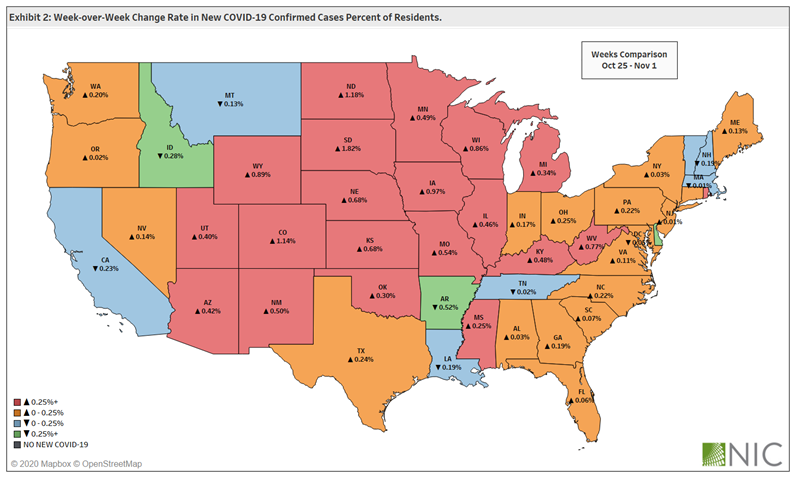Since May 31, 2020, NIC has been publishing a regular updated weekly surveillance report on the incidence of COVID-19 cases among residents in our nation’s nursing care properties. Using raw data collected and reported by the Centers for Medicare & Medicaid Services (CMS), NIC’s Skilled Nursing COVID-19 Tracker (Tracker) reports CMS nursing home data and provides insights into the rate of virus spread within skilled nursing properties.
The Tracker is an easy-to-use interactive visualization tool that shows where cases are spreading, slowing, or remaining flat. In addition, the Tracker provides charts and tables that depict the incremental week-over-week change rate in three important metrics on a same-store basis, i.e. the same nursing properties are tracked each week across regions, sub-regions, states, and counties. The metrics include: (1) new COVID-19 confirmed cases per same store properties, (2) new COVID-19 confirmed cases as a share of residents, and (3) occupancy rates (based on CMS Data). Importantly, the Tracker allows users to drill down to a smaller market or a specific property and access the underlying data. The Tracker is available in the NIC COVID-19 Resource Center.
As a backdrop, COVID-19 cases are accelerating at a worrying pace across the U.S. and alarming new records are being set every day. According to the Johns Hopkins Coronavirus Resource Center, there were 11,065,237 cases in the U.S. as of November 16, 2020, and 246,626 deaths. This is up from 8,833,396 and 227,000, respectively, as recently as October 28, 2020. Moreover, there were 166,000 new cases and 73,014 hospitalizations reported on Monday, November 16, 2020 according to Johns Hopkins University and the COVID Tracking Project.
For the U.S., these figures represent 19% of the world’s cases and deaths, a disproportionate amount for a nation that only represents 4.3% of the globe’s population. While the mortality rates associated with COVID have declined, the rising incidence rate is disturbing, particularly for operators of seniors housing and skilled nursing properties, given the health vulnerabilities and comorbidities of these populations. Further, staff of these properties have been relentless in their efforts to combat the virus and safeguard residents and a level of exhaustion and fatigue exists for virtually everyone. Unfortunately, heightened diligence is further warranted.
 Exhibit 1 – Source: NIC Skilled Nursing COVID-19 Tracker*
Exhibit 1 – Source: NIC Skilled Nursing COVID-19 Tracker*
The Tracker shows that new infections are on the rise across skilled nursing properties, but the coronavirus hot spots are changing over time within the four regions of the U.S.—Midwest, Northeast, South and West. The trends depicted in Exhibit 1 show when each of the regions peaked in terms of COVID-19 confirmed cases as a share of residents. The number of new cases was highest in the Northeast in late May and reached 1.35% of residents testing positive, whereas the South and West regions peaked in late July and reported 1.50% and 1.29% of new confirmed cases as a share of residents, respectively.
For the week ending November 1, the Tracker shows that positivity rates are increasing dramatically and reaching very undesirable numbers in the Midwest. In the Midwest, all 12 states saw an increase in new COVID-19 confirmed cases from the prior week (October 25). The data also show new confirmed cases in skilled nursing properties reached a record high in the Midwest: 4,688 new cases within 4,499 facilities, or the equivalent to 1.66% of newly confirmed cases among residents. The South reported the second highest rate of 0.91%, followed by the West (0.58%) and Northeast (0.37%).
Although the West and Northeast reported cases remain relatively low compared to the Midwest and South regions, the Northeast saw an uptick in new confirmed cases on November 1, increasing by nearly 0.2% from the week ending October 11. Just like the overall new confirmed cases across the country rising to new records, the new confirmed cases in skilled nursing properties hit new highs on November 1, nearly 1% of residents testing positive within the U.S. skilled nursing properties.
Because of this outbreak of COVID-19 cases, new rules are being reimposed across the U.S. These requirements include more frequent testing, greater emphasis on physical distancing, and masking guidelines. These restrictions continue to be the best weapon against the virus until a vaccine is approved and widely distributed.
The U.S. map in Exhibit 2 below shows the week-over-week change in new COVID-19 confirmed cases as a share of residents within skilled nursing properties by state, as of November 1. Over 40 states showed an increase in new confirmed cases from the prior week (October 25).
 Exhibit 2 – Source: NIC Skilled Nursing COVID-19 Tracker*
Exhibit 2 – Source: NIC Skilled Nursing COVID-19 Tracker*
To gain in-depth insights and track the week-over-week change rate for new resident cases of COVID-19 within skilled nursing properties, visit NIC.org. You can also access the Skilled Nursing COVID-19 Tracker along with a rich trove of analysis and insight on the NIC COVID-19 Resource Center.
NIC is committed to provide data, analyses and insights that increase transparency and understanding of the sector, especially in this difficult time of COVID-19. We strongly support all actions and efforts that prioritize testing and availability of PPE to protect frontline workers and residents.
*CMS Data – As of November 1